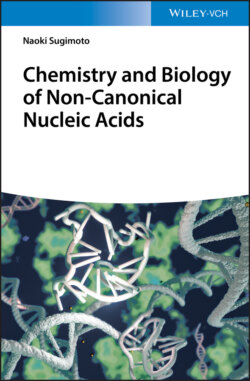Читать книгу Chemistry and Biology of Non-canonical Nucleic Acids - Naoki Sugimoto - Страница 19
2.1 Introduction
ОглавлениеNucleic acids are basically molecules with a high degree of structural flexibility and polymorphic property. Phosphates in nucleic acids are negatively charged and cause electrostatic repulsion in each phosphate moiety. This electrostatic repulsion is disadvantageous for nucleic acids to form a compact and ordered structure. Nucleic acids form the higher-order structures by offsetting unfavorable entropy changes and electrostatic repulsion by internal interactions such as hydrogen bonding and stacking interactions and external factors such as interactions of nucleic acids with cations and cosolutes. In other words, the canonical nucleic acid structure consisting of double helix with Watson–Crick base pairs is a part of the possible structural forms, and nucleic acids form various non-canonical structures depending on the internal and external factors. This chapter shows basic elements that form non-canonical nucleic acid structures including unusual base pairing, whose existence has been revealed by structural analyses, and their properties of thermodynamic stabilities. Detailed analyses of the stabilities of nucleic acid structures and factors that affect them are explained in Chapter 3.
